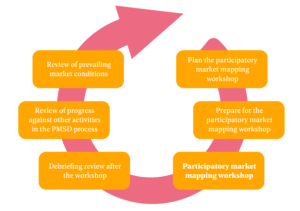Participatory market mapping
In a nutshell: Participatory Market Mapping is a key part of PMSD. It involves flexible workshops that bring market actors together to understand the market system and find ways to support inclusivity and market growth. This ensures local actors can take ownership and lead change. It can also be tailored to support gender equity and resilience.
Core Guidance: Participatory Market Mapping Guidance
Status: Core Tool
Key principles: Market Mapping puts Systems Thinking into practice by helping market actors understand their relationships and connections. It also promotes Participation, as marginalised groups learn how markets work and begin building trust with more powerful actors. Good Facilitation is key—helping actors reach their own conclusions, build a shared vision, and manage conflicts. It also supports Gender outcomes by giving women a platform to participate equally and by encouraging analysis of gender dynamics to drive meaningful change.
Timeline and resources: Traditionally, Participatory Market Mapping has been the central activity in a PMSD project, with substantial staff resources allocated for planning, facilitation and follow-up. Quarterly workshops are a loose guideline, but it works best when facilitators can move quickly to respond to market actors’ interests. Overall, this tool is an iterative process, following the cycle below.
Outputs
A key focal point of this process is the Market Map itself. A key differentiator in PMSD compared to traditional market systems approaches is that the market map is actively shared and co-created with market actors themselves – reflecting the principles of Participation and Facilitation. It is not enough for the programme to understand the system, and rather, actors themselves should gain new insights that shift their perspective. The process also enables market actors to better understand each other and develop relationships. As a result, a participatory mapping workshop is not just about planning, it is a market systems development intervention in its own right.
Figure: Participatory Market Mapping is an iterative process

Outcomes/behaviour changes
The ideal Participatory Market Mapping process takes market actors on a journey of reflection and changing of perspective. This will differ based on context, but four key milestones to watch out for are shown below. These reflect four key changes in attitude:
- From an individualistic view of the market to a shared understanding of the market as a system. This is achieved as the market actors develop the Market Map together, based on a participatory visual of the market system (the Market Map).
- From a perception of individual problems and blame to one in which it is recognised that each other’s problems are parts of the same system. This is achieved as market actors unpack problems and see how they are interconnected, ultimately affecting everyone.
- From many blockages and no common direction to common interests and a shared vision. Facilitation in Participatory Market Mapping aims to help market actors recognise that they have common interests in addressing the underlying problems in the market.
- From brainstorm of ideas for solutions to clear coordinated plans of action. Participatory Market Mapping is not a talk shop. If well run, it should help market actors identify a set of coordinated actions that improve inclusivity and growth. The may be taken forward in Market Interest Groups – groups of market actors who agree to collaborate to address a specific constraint identified in the market system.
Figure: PMSD milestones
